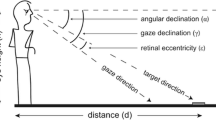Abstract
Naive observers (N = 75) were asked to saccade in the dark across a point light source blinking on and off at 200 Hz and to describe the resultant phantom array (Hershberger, 1987). The vast majority represented this perisaccadic illusion of visual direction essentially as Hershberger described it. Replicable features of the phantom array imply that the perisaccadic shift of retinal local signs (i.e., spatiotopic coordinates) is discontinuous, comprising two separate parts, a discrete partial shift that occurs before the eyes start to move, and a continuous partial shift that is completed at about the same time as the eye movement. Although these implications are consistent with recent experimental findings, they are inconsistent with the received view that retinal local signs shift sluggishly. The phantom array implies that the faster, presaccadic, partial shift has a time constant of 5 ms or less.
Similar content being viewed by others
References
BECKER, W., & JÜRGENS, R. (1975). Saccadic reactions to double-step stimuli: Evidence for model feedback and continuous information uptake. In G. Lennerstrand & P. Bach-y-Rita (Eds.), Basic mechanisms of ocular motility and their clinical implications (pp. 519–524). New York: Pergamon Press.
DASSONVILLE, P., SCHLAG, J., & SCHLAG-REY, M. (1992). Oculomotor localization relies on a damped representation of saccadic eye displacement in human and nonhuman primates. Visual Neuroscience, 9, 261–269.
DUHAMEL, J-R., COLBY, C. L., & GOLDBERG, M. E. (1992). The updating of the representation of visual space in parietal cortex by intended eye movements. Science, 255, 90–92.
GRÜSSER, O.-J. (1986). Interaction of efferent and afferent signals in visual perception. A history of ideas and experimental paradigms. Acta Psychologica, 63, 3–21.
GRÜSSER, O.-J., KRIZIC, A., & WEISS, L.-R. (1987). Afterimage movement during saccades in the dark. Vision Research, 27, 215–226.
HERSHBERGER, W. (1987). Saccadic eye movements and the perception of visual direction. Perception & Psychophysics, 41, 35–44.
HERSHBERGER, W. A., & JORDAN, J. S. (1992). Visual direction constancy: Perceiving the visual direction of perisaccadic flashes. In E. Chekaluk & K. R. Llewellyn (Eds.), The role of eye movements in perceptual processes (pp. 1–43). Amsterdam: Elsevier/North Holland.
JORDAN, J. S., & HERSHBERGER, W. A. (1994). Timing the shift in retinal local signs that accompanies a saccadic eye movement. Perception & Psychophysics, 55, 657–666.
LIVINGSTONE, M., & HUBEL, D. (1988). Segregation of form, color, movement, and depth: Anatomy, physiology, and perception. Science, 240, 740–749.
MATIN, L. (1972). Eye movements and perceived visual direction. In D. Jameson & L. Hurvich (Eds.), Handbook of sensory physiology (Vol. 7/4, pp. 331–380). Heidelberg: Springer.
MATIN, L. (1976a). A possible hybrid mechanism for modification of visual direction associated with eye movements—the paralysed eye experiment reconsidered. Perception, 5, 233–239.
MATIN, L. (1976b). Saccades and extraretinal signal for visual direction. In A. Monty & J. W. Senders (Eds.), Eye movements and psychological processes (pp. 205–219). New York: Erlbaum.
MATIN, L. (1982). Visual localization and eye movements. In W. A. Wagenaar, A. H. Wertheim, & H. W. Leibowitz (Eds.), Symposium on the study of motion perception. New York: Plenum.
MATIN, L., & PEARCE, D. G. (1965). Visual perception of direction for stimuli flashed during voluntary saccadic eye movements. Science, 148, 1485–1488.
MITTELSTAEDT, H. (1958). The analysis of behavior in term of control systems. In B. Schaffner (Ed.), Group processes, Transactions of the Fifth Conference. New York: Josiah Macy, Jr., Foundation.
ROBINSON, D. A. (1975). Oculomotor control signals. In G. Lennerstrand & P. Bachy-Rita (Eds.), Basic mechanisms of ocular motility and their clinical implications (pp. 337–374). New York: Pergamon Press.
SHEBILSKE, W. L. (1977). Visuomotor coordination in visual direction and position constancies. In W. Epstein’s Stability and constancy in visual perception (pp. 23–69). New York: Wiley.
SKAVENSKI, A. A. (1972). Inflow as a source of extraretinal eye position information. Vision Research, 12, 221–229.
SKAVENSKI, A. A. (1976). The nature and role of extraretinal eye-position information in visual localization. In A. Monty & J. W. Senders (Eds.), Eye movements and psychological processes (pp. 277–287). New York: Erlbaum.
STEINBACH, M. J. (1987). Proprioceptive knowledge of eye position. Vision Research, 27, 1737–1744.
VON HOLST, E., & MITTELSTAEDT, H. (1950). Das Reafferenzprinzip. Naturwissenshaften, 37, 464–476.
Author information
Authors and Affiliations
Rights and permissions
About this article
Cite this article
Hershberger, W.A., Jordan, J.S. The Phantom Array: A Perisaccadic Illusion of Visual Direction. Psychol Rec 48, 21–32 (1998). https://doi.org/10.1007/BF03395256
Published:
Issue Date:
DOI: https://doi.org/10.1007/BF03395256




